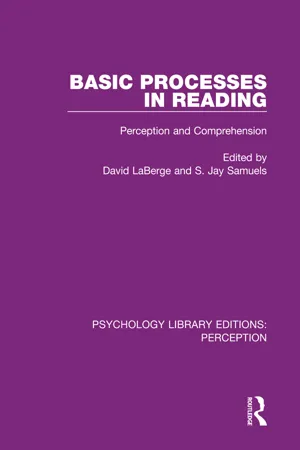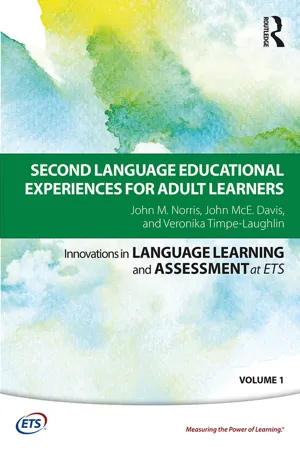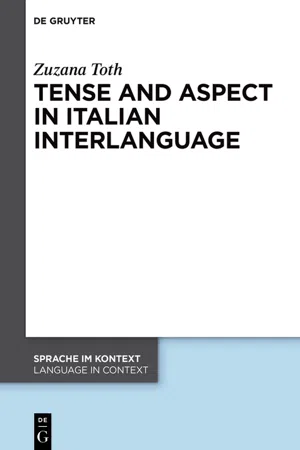Languages & Linguistics
Language Acquisition Support System
A Language Acquisition Support System (LASS) refers to the tools, resources, and strategies that facilitate the process of learning a language. This system can include formal instruction, immersion programs, language learning apps, and other forms of support that help individuals acquire and develop proficiency in a new language. LASS aims to provide learners with the necessary support to enhance their language acquisition skills.
Written by Perlego with AI-assistance
Related key terms
Related key terms
1 of 4
Related key terms
1 of 3
3 Key excerpts on "Language Acquisition Support System"
- eBook - ePub
Basic Processes in Reading
Perception and Comprehension
- David LaBerge, S. Jay Samuels(Authors)
- 2017(Publication Date)
- Routledge(Publisher)
The purpose of this chapter is to report the successor to LAS I, appropriately dubbed LAS II. This program is quite similar in basic concept to the LAS I program. However, a few important additions have been made that greatly increase the program’s power as a language user. The remainder of this chapter is devoted to description and evaluation of LAS II. The next section will describe LAS as a language user –how it uses its knowledge of the language, once acquired, to speak and understand sentences of the language. This will give a picture of what the end product of the language learning process will be. It will be easier to understand the learning program with this perspective. Then the third section will discuss the basic principles embodied in the language learning program and present evidence for these. The next section will consider some case studies of the LAS II program learning English and French. Finally, the fifth section will provide some summary evaluations of the LAS II program. It will also outline some of my ideas for a third-pass language learning program, which will be somewhat different from LAS I or II.Before embarking on a description of LAS, I should make it clear what LAS is a theory of. It is not, as it is currently structured, a theory of child language acquisition. It makes certain assumptions about the cognitive development of the learner that are not properly satisfied in the case of a child learning his first language. It is also not a model of an adult learning a language in a classroom situation. It assumes that the learner must induce the rules of the language from examples; that is, the rules are not presented in textbook fashion. Rather, LAS is a model of an adult who must learn the language in a free learning situation from interactions in the language with speakers of the language. The fact that LAS is not properly a model of first language acquisition or classroom language acquisition does not mean that data will not be used from these sources, only that these data must be interpreted with some caution. It is also the case that I eventually aspire to have LAS say something about these other two forms of language acquisition. However, the LAS program that will direct itself to these matters is probably many years away.Las as a Language User
The LAS Language System
The LAS language system is not very interesting as a serious attempt to model the complexities of language comprehension and production. It is clearly dwarfed by the very impressive programs of workers in artificial intelligence such as Winograd (1972) or Schank (1972). Its principal significance is that it provides a coherent, if simplified, framework in which to conceptualize the language acquisition problem.Fig. 1 - John M. Norris, John McE. Davis, Veronika Timpe-Laughlin(Authors)
- 2017(Publication Date)
- Routledge(Publisher)
This brief overview of selected, if relatively influential, theories and research shows SLA as an “epistemologically diverse area of enquiry affording varying and sometimes conflicting accounts of the same phenomena” (Ellis & Shintani, 2014, p. 27). Thus, there is no unified framework or a type of SLA recipe that fully accounts for L2 learning. Nor is there evidence that would establish the superiority of a particular theoretical approach for informing best practice decisions about how to frame, design, or evaluate L2 educational experiences. Instead, the controversy and discussion of how L2 acquisition occurs is ongoing, driving the field forward and inspiring ever new inquiries and theorizing into the potential processes that constitute L2 learning. However, to the extent possible, we share Ellis and Shintani’s (2014) proposition that teaching should proceed in accordance with how learners learn—that is to say, “[i]nstruction that is not compatible with the way L2 acquisition takes place cannot be successful” (p. 27).Furthermore, the majority of the SLA theories discussed previously highlight the development of grammar and morphology as a core feature of L2 acquisition, yet it is important to note that language learning and the development of communicative language ability (CLA) in particular go far beyond mere grammatical knowledge. First, language ability is generally viewed as a complex communication system that needs to be acquired and analyzed on multiple levels,3 including language skills (listening, reading, speaking, and writing) and components of the language system that cut across the four skills (phonology, lexicogrammar, semantics, pragmatics, and discourse).4 Second, L2 language skills and components can be acquired for very different (communicative) purposes, such as “survival” in a foreign country, to develop literacy in a target language (McKay, 1993), for academic or esthetic (e.g., literary) language use (e.g., Johnson, 2012; Zwiers, 2008), or to communicate with other L2 learners using the target language as a lingua franca (e.g., Jenkins, 2000, 2012; Seidlhofer, 2011) or as an international language (e.g., McKay, 2002).Given that language ability constitutes such a complex, protean phenomenon, L2 instruction needs to facilitate L2 acquisition for the learner by providing language learning experiences that aim to foster different language skills, language components, and their use in different language use contexts. SLA theories can function as a rough set of guidelines for educators to design these language learning experiences, as can findings from ISLA research. That is to say, although SLA theories cannot be translated directly into L2 pedagogy, certain principles can be derived from SLA theories that can then help operationalize and implement key ideas of SLA theories in L2 instruction, as suggested in the following recommendations.- eBook - ePub
- Zuzana Toth(Author)
- 2020(Publication Date)
- De Gruyter(Publisher)
They take into account all the languages forming the individual’s linguistic background and treat them as part of a multilingual system, where individual languages are not seen as autonomous entities, but as interdependent language systems (Jessner 2008 : 273). The focus on multilingual systems rather than autonomous languages is one of the properties that distinguishes TLA from SLA studies. The latter field often displays a monolingual bias, meaning that it focuses on one language defined as “second” with respect to a “unitary and singular ‘first’ as a predecessor” (Block 2014 : 54). Thus, SLA studies tend to adopt an additive view of linguistic competence, and treat IL development as separate from the L1, culminating in the complete command of two separate languages, that is a “dual monolingual competence” (Block 2014 : 55). When focusing on languages acquired after the first non-native language, SLA studies tend to disregard the effect of prior non-native languages on the acquisition process, and to take into account only the L1 from the learners’ linguistic backgrounds (Hammarberg 2009 : 1). Thus, from an SLA perspective, multilingual learners tend to be treated as monolinguals, influenced by one linguistic system, their L1, which interacts with the linguistic systems being acquired. This approach is based on the assumption that the role of previously learned non-native languages in the acquisition process is not significant (Hammarberg 2001 : 22). TLA studies, on the contrary, emphasise the presence of qualitative differences between the acquisition of the first non-native language and additional languages (Jessner 2008 : 270). When acquiring the first non-native language, the learner develops “a metasystem that is based on a bilingual norm” (Jessner et al. 2016 : 160). Given the presence of a bilingual norm, L3 acquisition is more complex than L2 acquisition, because multiple languages are involved in the acquisition process
Index pages curate the most relevant extracts from our library of academic textbooks. They’ve been created using an in-house natural language model (NLM), each adding context and meaning to key research topics.
Explore more topic indexes
Explore more topic indexes
1 of 6
Explore more topic indexes
1 of 4


